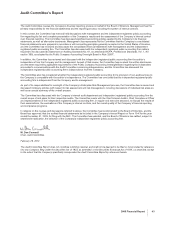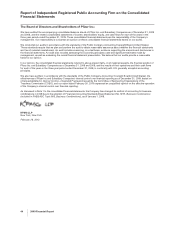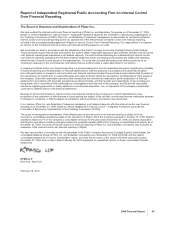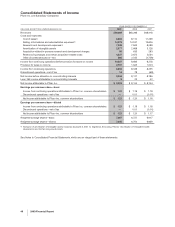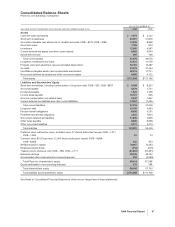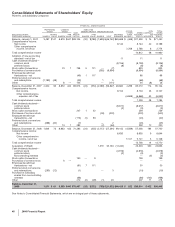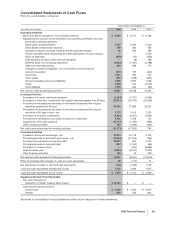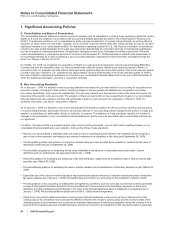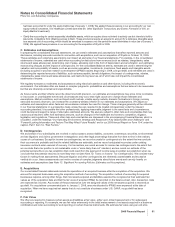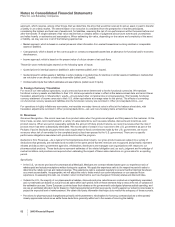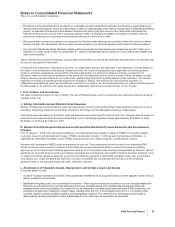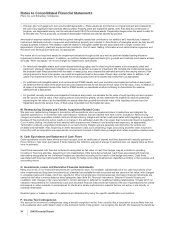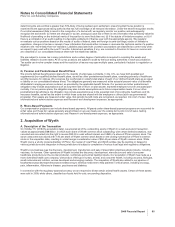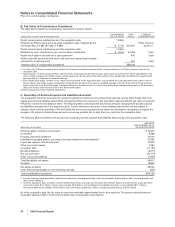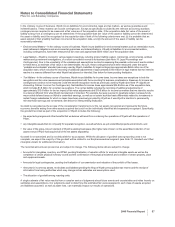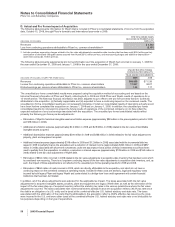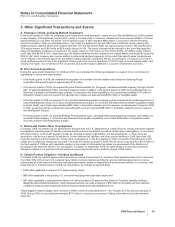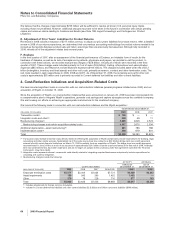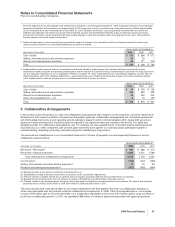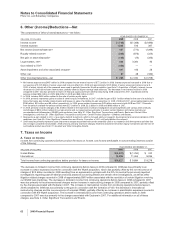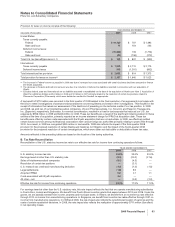Pfizer 2009 Annual Report Download - page 55
Download and view the complete annual report
Please find page 55 of the 2009 Pfizer annual report below. You can navigate through the pages in the report by either clicking on the pages listed below, or by using the keyword search tool below to find specific information within the annual report.
Notes to Consolidated Financial Statements
Pfizer Inc. and Subsidiary Companies
•Provisions for pharmaceutical returns are based on a calculation at each market that incorporates the following, as appropriate: local
returns policies and practices; returns as a percentage of sales; an understanding of the reasons for past returns; estimated shelf life by
product; an estimate of the amount of time between shipment and return or lag time; and any other factors that could impact the
estimate of future returns, such as loss of exclusivity, product recalls or a changing competitive environment. Generally, returned
products are destroyed, and customers are refunded the sales price in the form of a credit.
•We record sales incentives as a reduction of revenues at the time the related revenues are recorded or when the incentive is offered,
whichever is later. We estimate the cost of our sales incentives based on our historical experience with similar incentives programs.
•Our accruals for Medicaid rebates, Medicare rebates, performance-based contract rebates and chargebacks were $2.1 billion as of
December 31, 2009, and $1.5 billion as of December 31, 2008, and substantially all are included in Current deferred tax liabilities and
other current liabilities.
Taxes collected from customers relating to product sales and remitted to governmental authorities are presented on a net basis; that
is, they are excluded from Revenues.
Collaborative Arrangements––Payments to and from our collaboration partners are presented in the statement of income based on
the nature of the arrangement (including its contractual terms), the nature of the payments and applicable accounting guidance.
Under co-promotion agreements, we record the amounts received from our partners as alliance revenues, a component of
Revenues, when our co-promotion partners are the principal in the transaction and we receive a share of their net sales or profits.
Alliance revenues are recorded when our co-promotion partners ship the product and title passes to their customers. The related
expenses for selling and marketing these products are included in Selling, informational and administrative expenses. In
collaborative arrangements where we manufacture a product for our partner, we record revenues when our partner sells the product
and title passes to its customer. All royalty payments to collaboration partners are recorded as part of Cost of sales.
I. Cost of Sales and Inventories
We value inventories at lower of cost or market. The cost of finished goods, work in process and raw materials is determined using
average actual cost.
J. Selling, Informational and Administrative Expenses
Selling, informational and administrative costs are expensed as incurred. Among other things, these expenses include the costs of
marketing, advertising, shipping and handling, information technology and the associated employee compensation.
Advertising expenses relating to production costs are expensed as incurred, and the costs of radio time, television time and space in
publications are expensed when the related advertising occurs. Advertising expenses totaled approximately $2.9 billion in 2009,
$2.6 billion in 2008 and $2.7 billion in 2007.
K. Research and Development Expenses and Acquisition-Related In-Process Research and Development
Charges
Prior to January 1, 2009, when recording acquisitions, we expensed amounts related to acquired IPR&D in Acquisition-related
in-process research and development charges. IPR&D acquired after January 1, 2009, as part of a business combination, is
capitalized as Identifiable intangible assets. IPR&D acquired as part of an asset acquisition is expensed as incurred.
Research and development (R&D) costs are expensed as incurred. These expenses include the costs of our proprietary R&D
efforts, as well as costs incurred in connection with certain licensing arrangements. Before a compound receives regulatory
approval, we record upfront and milestone payments made by us to third parties under licensing arrangements as expense. Upfront
payments are recorded when incurred, and milestone payments are recorded when the specific milestone has been achieved. Once
a compound receives regulatory approval, we record any milestone payments in Identifiable intangible assets, less accumulated
amortization and, unless the assets are determined to have an indefinite life, we amortize them evenly over the remaining
agreement term or the expected product life cycle, whichever is shorter.
L. Amortization of Intangible Assets, Depreciation and Certain Long-Lived Assets
Long-lived assets include:
•Goodwill—Goodwill represents the excess of the consideration transferred for an acquired business over the assigned values of its net
assets. Goodwill is not amortized.
•Identifiable intangible assets, less accumulated amortization—These acquired assets are recorded at our cost. Intangible assets with
finite lives are amortized evenly over their estimated useful lives. Intangible assets with indefinite lives that are associated with
marketed products are not amortized until a useful life can be determined. Intangible assets associated with IPR&D projects are not
amortized until approval is obtained in a major market, typically either the U.S. or the European Union (EU), or in a series of other
countries, subject to certain specified conditions and management judgment. The useful life of an amortizing asset generally is
determined by identifying the period in which substantially all of the cash flows are expected to be generated.
2009 Financial Report 53


